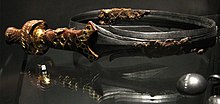Prince's grave

Prince grave or princesses grave is an obsolete archaeological term that usually a highlighted by particularly magnificent interior of grave goods and elaborate grave conditioning burial site describes. The term is usually used in relation to Celtic graves, but it can also be used for burials of other cultures .
The term princely grave is scientifically controversial because it makes a statement about a social structure that cannot be scientifically verified. This is why graves of this type have been referred to as ceremonial or elite graves in archeology since the mid-1970s .
"Celtic princely tombs"
Numerous find complexes or sites from the Celtic era are referred to as princely graves , for example the princely grave of Glauberg , that of Hochdorf an der Enz , the Hohmichele , the burial place of Vix , the prince grave hill Sonnenbühl and the largest known Celtic cult site on the Mormont . In addition to Vix, the princess of Reinheim in Saarland is also to be addressed as a princess grave.
No statement can be made today about the real social position of those buried at the time - that is, whether they were “ princes ”, “ chiefs ”, “merchants”, “ priests ”, but the prominent form of burial means that society is hierarchized clearly.
Celtic princely graves are mostly directly linked to so-called “princely seats”, a term coined by the prehistorian Wolfgang Kimmig . According to Kimmig, three criteria would be necessary to define a princely seat or the associated princely grave:
- The inner structure of the settlement: there must be a castle and a lower town
- The finds: Imported goods such as Massali wine amphoras or Attic black-figure ceramics must have been found on site
- Grave hill: In the immediate vicinity of at least a princely has grave mounds are
Examples of the connection to a nearby prince's seat are the Hochdorf grave, which is located in the vicinity of the Hohenasperg prince's seat , and the Hohmichele near the Heuneburg .
Other archaeological cultures
Outstanding burials are also referred to as princely graves in other cultures, such as the Franconian princely grave ( grave 1782 ) from Krefeld-Gellep and the Chaouilley grave 20, both of which belong in a similar context, or the princely grave of Planig in Rheinhessen and the royal grave of Mušov in Bohemia , which are of Germanic origin. The princely grave of Leubingen, on the other hand, dates back to the Bronze Age and was built by the supporters of the Aunjetitz culture .
literature
- Torsten Capelle , Otto-Herman Frey , Michael Fee , Heiko Steuer , Henrik Thrane: Prince's Graves. In: Reallexikon der Germanischen Altertumskunde (RGA). 2nd Edition. Volume 10, Walter de Gruyter, Berlin / New York 1998, ISBN 3-11-015102-2 , pp. 168–220 ( chargeable via GAO , De Gruyter Online).
- Franz Fischer: Early Celtic princely graves in Central Europe . Antique world special number 13, Feldmeilen 1982.
- Wolfgang Kimmig: On the problem of late Hallstatt aristocratic seats. In: Karl-Heinz Otto, Joachim Herrmann (eds.): Settlement, castle and city: studies on their beginnings. Akademie Verlag, Berlin 1969, pp. 95-113.
Web links
Remarks
- ↑ See, among others, Heiko Steuer: Princely graves, noble graves, elite graves - methodical to the anthropology of the ceremonial graves , in: Claus Carnap-Bornheim (Ed.): Herrschaft, Tod, Bestattung: to the prehistoric and early historical grand graves as archaeological-historical source. International conference Kiel 16. – 19. October 2003. Habelt, Bonn 2003, pp. 11-25. Online document from the University of Freiburg, accessed on December 28, 2011 (PDF; 470 kB)
- ↑ Echt, R: The princess grave of Reinheim. Studies on the cultural history of the early La Tène period. In: Foundation European Culture Park Bliesbruck / Reinheim (Ed.): Saarbrücker Contributions to Antiquity 69 . BLESA 2. Habelt, Bonn 1999, ISBN 3-7749-2952-1 , p. 358 .
